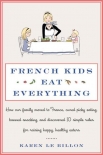French Kids Eat Everything Karen Billon (romance novel chinese novels txt) 📖

- Author: Karen Billon
Book online «French Kids Eat Everything Karen Billon (romance novel chinese novels txt) 📖». Author Karen Billon
It will be a kind of “food rebirthing,” I thought (although this was so hippie-sounding that I kept the term to myself). We’d pick a dozen vegetables and reintroduce them over a month. This would be our own family version of the kohlrabi experiment. I found inspiration in a cookbook by Cyril Lignac, the cantine crusader I had heard about from Sophie’s teacher. I had brought one of his cookbooks home from the library and enjoyed reading his astute sayings, which summed up the French philosophy nicely. My favorite was “In order to like a food, you first have to tame it.” I liked this idea, which suggested a gradual process of getting to know one another, of becoming intimately acquainted with something. As I read in another book that Christelle had sent to me (La naissance du goût [The Birth of Taste] by psychologist Natalie Rigal), this involved exploring new food with all of the senses—sight, smell, touch, taste, and even hearing.
This gave me some interesting new ideas about how to deal with potential refusals to eat the new things I’d be preparing. We’d try taste training, just like at school. If the kids didn’t want to taste the food at first, I could ask them to smell it, or describe it. They’d still be encountering the new food (and making progress, from the French perspective). But I had also learned from my research that actually getting kids to taste the food (even a little bit) was the trick to teaching them to like it. So by the third time it was on the table, the kids would have to taste it. But they wouldn’t have to eat it. As per the French approach, I wouldn’t provide substitutes, but I wouldn’t force them into eating either.
Poring over the cookbooks, I enthusiastically drew up our week’s “tasting menu,” as I decided to call it. I’d introduce one new vegetable per meal, in soup form. It would be served as a starter. After a little bit of hesitation, I picked leeks and spinach. They were both “mild” vegetables, according to the French, and the bold green colors would make it a challenge. I added red pepper because it was one of my favorite things to eat. And I included a simple red lentil puree, so that at least one of the soups would have a denser texture. For familiar comfort, I also chose carrots, hoping they’d be an easy winner.
The soups would be simple, I decided, and would be the same consistency as baby purees. Each would have only one or two primary ingredients, so that the tastes of the vegetables would come through. None of the recipes would have salt or spices (except for a bit of salted butter dabbed on top). Once the girls liked it, the food would reappear in a main dish (or in its raw form) later that week. And once they had learned to get used to new tastes every night, I’d start introducing the other French Food Rules, like banning snacks. But first we would make new food fun.
These ideas were inspiring, but one thing made me hesitate. The mess and extra work of making purees was not something I had been looking forward to. But once again the French proved their ingenuity when it comes to anything culinary. Some smart person had invented precisely what I needed—and what many French parents rely on. The “BabyCook” (beebee-kook, as my husband charmingly pronounced it) made a proud appearance on our countertop. Shaped like a little chopping machine, but with a unit on the side that you could fill with water (like the coffee makers in hotel rooms), the BabyCook would steam, blend, and puree your vegetables to the perfect consistency, all in one container (and reheat or even defrost them later if necessary). Voilà!
We were now ready to start off with Phase One of The Plan (version 2.0). Proudly, I pasted my menu on the now-crowded fridge.
It was my husband’s idea to feature fancy names for each dish. It didn’t matter that the kids couldn’t read yet: we read the names out to them, and everyone had agreed that they sounded more appetizing (or at least funny). Philippe got the idea from the cantine at the local school, which had menus that sounded more appealing than even fancy restaurants back home.
“It’s all in the marketing,” he told me one day, having driven Sophie home after listening to her talk with Marie about the beet salad they had eaten at lunch. “Half of it is in the visual presentation—the tablecloth, the cutlery, the napkins, the serving dishes—but half of it is in the names. Even young kids feel more interested if something has a nice name.”
At the time, I didn’t really believe him. But it was the first voluntary contribution he’d made to The Plan, so I decided to humor him. I remembered something I’d read in an in-flight magazine about marketing food to your kids—something about placing fruits and vegetables in attractive bowls, and giving things fancier names. The French call this l’art de la présentation: the art of presenting food.
Our French friends were only too happy to make suggestions, especially about making the kids feel that the table was a special place. Buying cute cutlery sets for the kids was one suggestion. We put out a request, and the girls soon had Babar, Barbapapa, Tintin, and the Petit Prince to choose from. Mamie brought over small bowls with little hand-painted scenes of children dressed in traditional Breton costumes; they had been personalized, with the girls’





Comments (0)